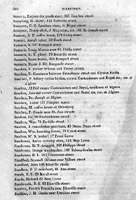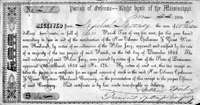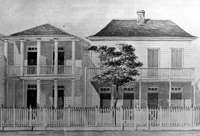
|  The 1842 Pitts & Clarke city
directory was the first to include the name Algiers in its title. The New-Orleans Directory for 1842, comprising
the names, residences and occupations of the merchants, business men, professional gentlemen and citizens of
New-Orleans, Lafayette, Algiers and Gretna, however, did not provide exact addresses for residences and businesses on
the right bank. These pages identify several Algerines including P. Sidney, Alfred, and Armand Sanchez who worked in
the Vieux Carre but lived in Algiers. The 1842 Pitts & Clarke city
directory was the first to include the name Algiers in its title. The New-Orleans Directory for 1842, comprising
the names, residences and occupations of the merchants, business men, professional gentlemen and citizens of
New-Orleans, Lafayette, Algiers and Gretna, however, did not provide exact addresses for residences and businesses on
the right bank. These pages identify several Algerines including P. Sidney, Alfred, and Armand Sanchez who worked in
the Vieux Carre but lived in Algiers.
|

|  Agriculture played an important role in the
Algiers economy throughout most of its history. During the 1850-1851 sugar-growing season the area was home to six
plantations as indicated in P. A. Champomier's Statement of Sugar Made in Louisiana. As late as 1906 the
Aurora and Stanton plantations were still producing 5.3 million pounds of sugar between them. Agriculture played an important role in the
Algiers economy throughout most of its history. During the 1850-1851 sugar-growing season the area was home to six
plantations as indicated in P. A. Champomier's Statement of Sugar Made in Louisiana. As late as 1906 the
Aurora and Stanton plantations were still producing 5.3 million pounds of sugar between them.
|

|  The minutes of the Police Jury of the
Parish of Orleans on the Right Bank of the River Mississippi provide us a glimpse of life in early Algiers. This entry,
from the session of January 7, 1853, refers to the Telegraph Coffee House, a river bank cave-in that required the closure
of Patterson Street, and the election of teachers for the Belleville and Duverjeville schools. The minutes of the Police Jury of the
Parish of Orleans on the Right Bank of the River Mississippi provide us a glimpse of life in early Algiers. This entry,
from the session of January 7, 1853, refers to the Telegraph Coffee House, a river bank cave-in that required the closure
of Patterson Street, and the election of teachers for the Belleville and Duverjeville schools.
|

|  The citizens of Algiers helped with their
tax dollars in the building of the New Orleans, Opelousas and Great Western Railroad. That firm, which evolved into the
Southern Pacific line, proved to be an important element in the economy of the right bank. The citizens of Algiers helped with their
tax dollars in the building of the New Orleans, Opelousas and Great Western Railroad. That firm, which evolved into the
Southern Pacific line, proved to be an important element in the economy of the right bank.
|

|  When John McDonogh died in 1850 he
left a vast inventory of real estate to the city of New Orleans. This 1860 catalog for the sale of the McDonogh lands
shows the extent of his holdings in Algiers and adjacent parts of Jefferson and Plaquemines Parishes. McDonogh's own
home, Monplaisir, lay just within Orleans Parish on the right bank. When John McDonogh died in 1850 he
left a vast inventory of real estate to the city of New Orleans. This 1860 catalog for the sale of the McDonogh lands
shows the extent of his holdings in Algiers and adjacent parts of Jefferson and Plaquemines Parishes. McDonogh's own
home, Monplaisir, lay just within Orleans Parish on the right bank.
|

|  These two buildings stood on Peters (now
Pelican) Street near Verret when this plan was drawn in 1866. The site is now occupied by two newer homes, perhaps
built shortly after the Algiers fire of 1895. Betsy Swanson made this photograph from the original drawing in volume
forty-one of the plan books at the New Orleans Notarial Archives. These two buildings stood on Peters (now
Pelican) Street near Verret when this plan was drawn in 1866. The site is now occupied by two newer homes, perhaps
built shortly after the Algiers fire of 1895. Betsy Swanson made this photograph from the original drawing in volume
forty-one of the plan books at the New Orleans Notarial Archives.
|

|  Act 7 of the 1870 Louisiana Legislature
effected the annexation of Algiers by the city of New Orleans. The law also brought Jefferson City, part of Jefferson
Parish, into the limits of the Crescent City. Act 7 of the 1870 Louisiana Legislature
effected the annexation of Algiers by the city of New Orleans. The law also brought Jefferson City, part of Jefferson
Parish, into the limits of the Crescent City.
|